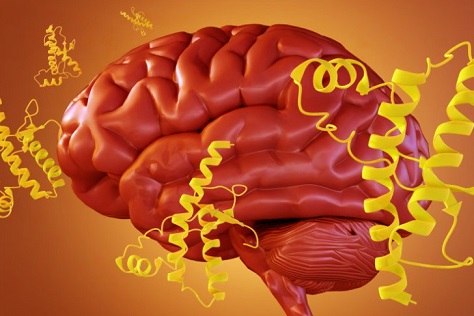Nikhil Prasad Fact checked by:Thailand Medical News Team Nov 11, 2024 11 months, 3 weeks, 6 days, 9 hours, 18 minutes ago
Medical News: Understanding TDP-43 Proteinopathies: What You Need to Know
In recent studies, scientists have identified prion-like behaviors in the TDP-43 protein, offering insights into how diseases like ALS and Frontotemporal Lobar Degeneration (FTLD) progress. The research, conducted by Emma Pongrácová and Emanuele Buratti at the International Centre for Genetic Engineering and Biotechnology in Italy, alongside Maurizio Romano from the University of Trieste, dives deep into how TDP-43 misfolds and spreads in the brain, creating a cascade effect.
 How TDP-43 Spreads in Brain Diseases Like a Prion
How TDP-43 Spreads in Brain Diseases Like a Prion
This
Medical News report explores TDP-43's potential to act as a "seed" for misfolding, contributing to neurodegenerative diseases by spreading abnormally folded proteins across brain cells.
What Is TDP-43, and Why Does It Matter?
TDP-43 is a protein commonly found in the nucleus of cells, where it aids in RNA processing, a key part of protein synthesis. Under normal conditions, TDP-43 is crucial for cellular function. However, in TDP-43 proteinopathies, such as ALS (Amyotrophic Lateral Sclerosis) and FTLD, TDP-43 proteins misfold, move into the cytoplasm, and clump together, leading to neuronal damage and cell death.
Prion-like Spread of TDP-43: What the Research Says
The concept of "prion-like" spread refers to the ability of misfolded proteins to influence neighboring proteins to misfold in a similar way. Just like prions in diseases such as Creutzfeldt-Jakob Disease, TDP-43 appears to trigger a similar self-propagating cycle, but confined to the host and without infectious spread between individuals.
Seed-Dependent Aggregation: How It Starts
Researchers found that once TDP-43 misfolds, it acts as a "seed," encouraging other TDP-43 molecules to misfold as well. This aggregation is believed to occur via direct cell-to-cell transfer, a phenomenon also observed in other neurodegenerative disorders.
TDP-43 Travels Through Vesicles and Nanotubes
In studies, scientists observed TDP-43 spreading from cell to cell via vesicles, small particles that can carry proteins and genetic material between cells, and tunneling nanotubes (TNTs). These processes enable TDP-43 aggregates to migrate between cells, transferring the misfolded proteins throughout neural networks and further driving disease spread.
Key Study Findings and Their Implications
-Different "Strains" of TDP-43
TDP-43 can form different "strains" or structural variations with varying levels of toxicity and propagation. Researchers found that TDP-43 strains from different patients had unique spreading capacities, suggesting that each strain might contribute to the variation in symptoms and progression among TDP-43 proteinopathies. This characteristic is similar to prions, where different strains re
sult in different disease presentations.
-The Role of Cellular Prion Protein (PrPC)
Interestingly, PrPC, a protein usually associated with classic prion diseases, has been shown to enhance the internalization and toxicity of TDP-43 aggregates in nerve cells. This means that PrPC may play a role in the prion-like spread of TDP-43, potentially amplifying its neurotoxic effects in patients.
Potential Therapeutic Avenues: Can We Stop TDP-43 from Spreading?
Since TDP-43 spreads in a manner similar to prions, understanding this process opens up new possibilities for treatments that could prevent or reduce its propagation. Here are some of the proposed therapies from the study.
-Targeting TDP-43 Aggregation Directly
Inhibiting TDP-43's ability to misfold could be one approach. Small molecules are being explored to block the aggregation process, stabilizing TDP-43 in its normal structure and reducing its toxic effects on cells.
-Immunotherapy: Using Antibodies to Halt Spread
Immunotherapy offers a promising approach by using engineered antibodies to target the abnormal TDP-43 aggregates specifically. These antibodies, once introduced into the body, could latch onto TDP-43 clumps, preventing them from spreading and causing further damage.
-Intrabody Therapy: An Inside Job
Another exciting approach is intrabody therapy, where antibodies are delivered directly inside cells to target TDP-43. These "intrabodies" can bind to and eliminate misfolded TDP-43, reducing its aggregation and, in animal studies, improving symptoms associated with the disease.
-Targeting Cellular Cleanup Mechanisms
Autophagy, the cell’s waste disposal system, and the ubiquitin-proteasome system, responsible for protein degradation, are vital in managing misfolded proteins. Therapies that enhance these processes could improve TDP-43 breakdown, keeping its levels under control and potentially reducing its prion-like spread.
Conclusions: What These Findings Mean for Future Research and Treatment
The research suggests that TDP-43 has a self-propagating nature, making it a challenging target for treatment. However, with prion-like properties that allow it to induce similar misfolding in healthy TDP-43 proteins, targeting its propagation is key. From small molecules to immunotherapies, the future of managing TDP-43-related neurodegenerative diseases may hinge on our ability to interrupt this cycle.
Therapies that focus on preventing TDP-43 spread could slow or halt the progression of ALS, FTLD, and other TDP-43 proteinopathies. However, these treatments are still in the research stage, and further studies are needed to bring them into clinical use.
The study findings were published in the peer-reviewed journal: Brain Sciences.
https://www.mdpi.com/2076-3425/14/11/1132
For the latest on TDP-43 proteinopathies, keep on logging to Thailand
Medical News.
Read Also:
https://www.thailandmedical.news/news/french-study-finds-that-human-host-protein-tdp-43-plays-a-role-in-influenza-a-virus-replication
https://www.thailandmedical.news/news/%E2%80%98rogue%E2%80%99-protein,-tdp-43,-responsible-for-many-neurodegenerative-disorders-identified-with-inhibitors-being-developed
